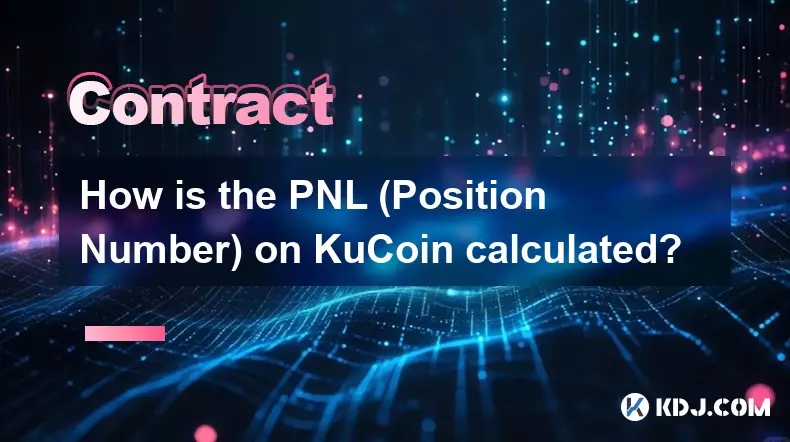-
 bitcoin
bitcoin $123963.239194 USD
1.37% -
 ethereum
ethereum $4529.082464 USD
1.07% -
 xrp
xrp $2.983640 USD
0.71% -
 tether
tether $1.000287 USD
0.02% -
 bnb
bnb $1179.874393 USD
2.99% -
 solana
solana $230.633678 USD
1.55% -
 usd-coin
usd-coin $0.999835 USD
0.03% -
 dogecoin
dogecoin $0.254240 USD
1.34% -
 tron
tron $0.341176 USD
0.15% -
 cardano
cardano $0.842285 USD
0.52% -
 hyperliquid
hyperliquid $48.537896 USD
-0.86% -
 chainlink
chainlink $21.863092 USD
-0.84% -
 ethena-usde
ethena-usde $0.999743 USD
-0.07% -
 sui
sui $3.579561 USD
-0.18% -
 stellar
stellar $0.403418 USD
2.67%
How is the PNL (Position Number) on KuCoin calculated?
KuCoin calculates PNL using entry vs. market price, factoring in funding rates, fees, and mark price to ensure accuracy and prevent manipulation.
Sep 19, 2025 at 04:37 pm

Understanding PNL Calculation on KuCoin
1. The Profit and Loss (PNL) on KuCoin is derived from the difference between the entry price of a position and the current market price or exit price. This value reflects how much a trader has gained or lost based on their open or closed positions in futures or margin trading. Realized PNL occurs when a position is fully or partially closed, while unrealized PNL shows the floating gain or loss on active positions.
2. For perpetual contracts, which are commonly traded on KuCoin Futures, PNL calculation depends on whether the position is long or short. In a long position, if the current price exceeds the entry price, the PNL is positive. Conversely, for a short position, a drop in price below the entry point generates profit. The formula adjusts accordingly to reflect directional exposure.
3. Funding rates also play a role in PNL calculations for perpetual swaps. Traders either pay or receive funding every eight hours depending on the prevailing rate and their position direction. These periodic payments directly impact the net PNL, especially for positions held across multiple funding intervals.
4. The leverage applied does not alter the PNL formula itself but amplifies both gains and losses. A 10x leveraged position will experience ten times the price movement effect compared to a spot trade. However, higher leverage increases the risk of liquidation, which truncates the PNL at the point of position closure by the system.
5. Fees associated with opening and closing trades are deducted from the final PNL. Taker fees apply when liquidity is removed, while maker fees apply when orders rest on the order book. These costs are factored into realized PNL, reducing net profits or increasing net losses accordingly.
Components Influencing PNL Accuracy
1. The accuracy of PNL on KuCoin relies heavily on precise mark prices. To prevent manipulation, the platform uses a mark price rather than the last traded price to calculate unrealized PNL. This mark price is typically derived from external price indexes and fair pricing models.
2. Liquidation engines use the mark price to determine when a position breaches its maintenance margin threshold. When this happens, the position is closed automatically, and the PNL is locked in at that moment. This mechanism ensures fairness during volatile market conditions.
3. Price feeds from multiple sources are aggregated to generate reliable index prices. These feeds help maintain consistency in PNL reporting across different trading pairs and contract types, minimizing discrepancies due to isolated exchange anomalies.
4. Slippage during execution can cause deviations between expected and actual PNL. Market orders filled at less favorable prices than anticipated reduce profitability, particularly in fast-moving markets with low liquidity.
5. Currency conversion rates may affect PNL when settlements occur in a denomination different from the user’s base currency. Exchange rate fluctuations between transaction and settlement times introduce minor variances in reported values.
Types of PNL in KuCoin Futures
1. Unrealized PNL refers to the theoretical gain or loss on open positions. It changes dynamically as the market price fluctuates. This value remains hypothetical until the position is closed, at which point it becomes realized.
2. Realized PNL is calculated once a position is closed. It incorporates the entry and exit prices, deducts trading fees, and includes any funding payments made or received during the holding period.
3. Cross-margin systems pool all available balance within a wallet to cover potential losses. In such cases, PNL impacts the total equity visible in the account, affecting available margin for other positions.
4. Isolated margin mode assigns a fixed amount of collateral to a specific position. Here, PNL directly influences the health of that individual position without affecting others, making risk management more transparent.
5. PNL calculations reset upon position closure, ensuring each new trade starts with a clean valuation baseline. This prevents historical performance from distorting current risk assessments.
Frequently Asked Questions
How does KuCoin handle PNL during a forced liquidation?During forced liquidation, the system closes the position at the best available price to minimize further losses. The PNL is calculated using the liquidation price and includes any remaining insurance fund deductions or clawbacks, if applicable.
Can I view my PNL history over time on KuCoin?Yes, users can access detailed PNL history through the Futures trading interface under the “Income” or “Transaction History” sections. Each entry logs realized PNL, funding payments, and fee deductions chronologically.
Does hedging impact PNL calculation on KuCoin?Hedging allows holding both long and short positions simultaneously. PNL is computed separately for each leg of the hedge. Net PNL aggregates both sides, providing a comprehensive view of overall profitability.
Why does my unrealized PNL differ from other platforms?Differences arise due to variations in mark price methodologies, index sources, and funding mechanisms. KuCoin’s model prioritizes anti-manipulation safeguards, which may result in slight deviations from exchanges using last-traded prices.
Disclaimer:info@kdj.com
The information provided is not trading advice. kdj.com does not assume any responsibility for any investments made based on the information provided in this article. Cryptocurrencies are highly volatile and it is highly recommended that you invest with caution after thorough research!
If you believe that the content used on this website infringes your copyright, please contact us immediately (info@kdj.com) and we will delete it promptly.
- BlockDAG, DOGE, HYPE Sponsorship: Crypto Trends Shaping 2025
- 2025-10-01 00:25:13
- Deutsche Börse and Circle: A StableCoin Adoption Powerhouse in Europe
- 2025-10-01 00:25:13
- BlockDAG's Presale Buzz: Is It the Crypto to Watch in October 2025?
- 2025-10-01 00:30:13
- Bitcoin, Crypto, and IQ: When Genius Meets Digital Gold?
- 2025-10-01 00:30:13
- Stablecoins, American Innovation, and Wallet Tokens: The Next Frontier
- 2025-10-01 00:35:12
- NBU, Coins, and Crypto in Ukraine: A New Yorker's Take
- 2025-10-01 00:45:14
Related knowledge

What is the difference between futures and perpetual contracts for Bitcoin?
Oct 02,2025 at 11:54pm
Understanding Bitcoin Futures Contracts1. Bitcoin futures are derivative instruments that allow traders to speculate on the future price of Bitcoin at...

What is the best time to trade PEPE contracts?
Oct 03,2025 at 11:54am
Understanding PEPE Contract Volatility1. PEPE contracts exhibit extreme price fluctuations due to their meme-based nature and low market cap. Trading ...

What are the common mistakes to avoid with Bitcoincoin contracts?
Oct 03,2025 at 08:54am
Emerging Trends in the Cryptocurrency Market1. Decentralized finance (DeFi) platforms continue to expand their influence across the blockchain ecosyst...

What is the maintenance margin for Bitcoin contracts?
Oct 02,2025 at 01:36am
Decentralized Exchanges Gain Momentum in 20241. Decentralized exchanges (DEXs) have seen a significant rise in trading volume, surpassing centralized ...

How to use technical analysis for trading XRP contracts?
Oct 03,2025 at 01:18pm
Understanding Price Patterns in XRP Futures1. Identifying chart patterns such as triangles, head and shoulders, and double tops or bottoms can provide...

What does "longing" PEPE contracts mean?
Oct 03,2025 at 11:54pm
Understanding Decentralized Exchanges in the Crypto Ecosystem1. Decentralized exchanges (DEXs) operate without a central authority, allowing users to ...

What is the difference between futures and perpetual contracts for Bitcoin?
Oct 02,2025 at 11:54pm
Understanding Bitcoin Futures Contracts1. Bitcoin futures are derivative instruments that allow traders to speculate on the future price of Bitcoin at...

What is the best time to trade PEPE contracts?
Oct 03,2025 at 11:54am
Understanding PEPE Contract Volatility1. PEPE contracts exhibit extreme price fluctuations due to their meme-based nature and low market cap. Trading ...

What are the common mistakes to avoid with Bitcoincoin contracts?
Oct 03,2025 at 08:54am
Emerging Trends in the Cryptocurrency Market1. Decentralized finance (DeFi) platforms continue to expand their influence across the blockchain ecosyst...

What is the maintenance margin for Bitcoin contracts?
Oct 02,2025 at 01:36am
Decentralized Exchanges Gain Momentum in 20241. Decentralized exchanges (DEXs) have seen a significant rise in trading volume, surpassing centralized ...

How to use technical analysis for trading XRP contracts?
Oct 03,2025 at 01:18pm
Understanding Price Patterns in XRP Futures1. Identifying chart patterns such as triangles, head and shoulders, and double tops or bottoms can provide...

What does "longing" PEPE contracts mean?
Oct 03,2025 at 11:54pm
Understanding Decentralized Exchanges in the Crypto Ecosystem1. Decentralized exchanges (DEXs) operate without a central authority, allowing users to ...
See all articles










































































